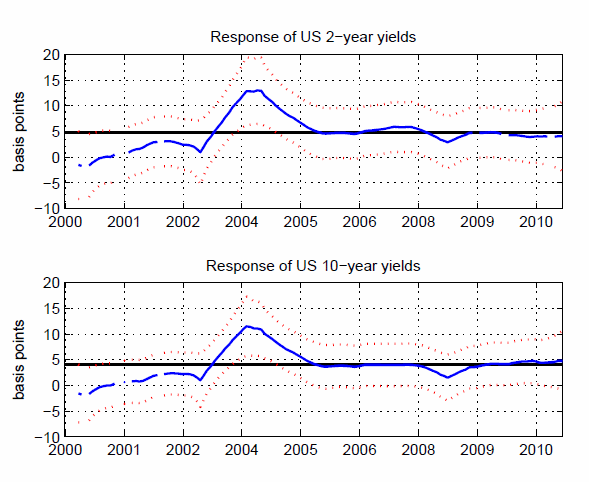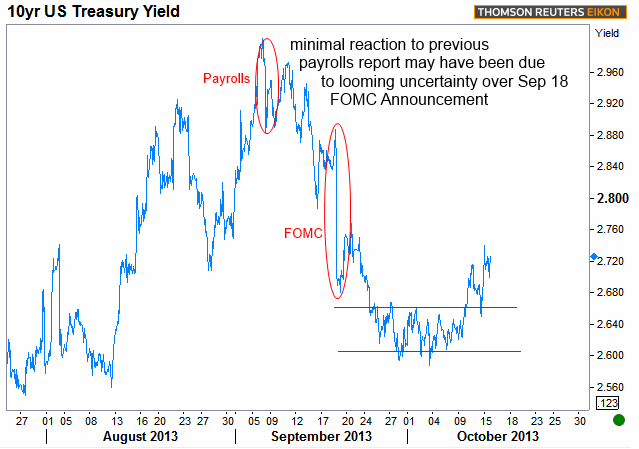Blog

One Reason Next Jobs Report Could Pack Bigger Punch
Markets usually react instantly to significant and unexpected financialrnnews. But a New York Federal Reservernanalyst says these reactions, rather than being knee-jerk, do take into accountrnother prevailing factors in addition to the news itself. LindarnGoldberg vice president in the Bank’s Researchrnand Statistics Group, examines the effect of economic news on asset prices in recent NY Fed staff paper.</p
Goldberg says that most analyses find that economic news isrnincorporated very quickly, perhaps within minutes into asset prices and thatrnthe effect persists for a measurable amount of time and can spill acrossrnnational borders. Announcements that arerntimely, precise, and contain more information generally generate the greatestrneffect on asset prices</p
The impact of news on asset prices is often discussed as though therernis some governing rule. For example thatrna movement of “x” basis points should result from a surprise in the payrollsrnannouncement to a degree mathematically proportionate to the level surprise. However, Goldberg found there is little reason to expect that the relationship betweenrneconomic news and asset prices should be stable over time. </p
The reason for this is basicallyrncontext. At different points in time thernexpected market reaction can change due to prevailing factors such asrnchanging risk preferences in the economy or the state of that economy as itrnmoves closer to or further from targets. The difference in the effect of arn”unit of news” on asset prices can be quite large at different points in time. <br /<br /Goldberg focused on several announcements with 8:30 a.m. releases. The table below focuses on one of these,<bnonfarm payrolls, over an eleven-year interval and examined the effects onrnasset prices. The data releasesrngenerally had a significant effect on the yields of U.S.rnTreasuries. Shownrnare the two and ten year bonds and she says the effects are clear withinrnminutes of the announcement. </p
Goldberg found that the biggest market movements generally occur when the market reaction isn’t behaving normally. In other words, if we examine the last 13 years of nonfarm payrolls releases compared to their forecast, we could observe that a certain magnitude of “better-than-expected” data corresponds to a certain direction of movement in bond markets. In the chart below, the average movement would be the flat black line. The blue line is the actual reaction, rising into positive territory when bonds are reacting more positively for a given level of “surprise.” In other words, this is a chart of how the correlation between data and market reaction has changed over time.<br / <br /<br /Thernhigh point in the chart was during a period of robustrneconomic growth in 2004 when the Federal Reserve began a series ofrn25-basis-point rate hikes and the low point was in the fall of 2008,rnparticularly in the period before and after the Lehman bankruptcy. Goldberg suggests that underlying changes in sentiment among investors can predispose certain assets to react more strongly or negatively than they otherwise might. </p
<br /<br /Thernhigh point in the chart was during a period of robustrneconomic growth in 2004 when the Federal Reserve began a series ofrn25-basis-point rate hikes and the low point was in the fall of 2008,rnparticularly in the period before and after the Lehman bankruptcy. Goldberg suggests that underlying changes in sentiment among investors can predispose certain assets to react more strongly or negatively than they otherwise might. </p
Periods of high risk and uncertainty greatly decrease the tendency to “overdo” the typical reaction. During these times, bond market yields already have some preexisting benefit from the quintessential “flight-to-safety” buying. Such an environment may also lead market participants to assume the data isn’t necessarily indicative of the true nature of the economy when the uncertainty and risk subside. Taken together, these suggest a bigger surprise in either direction will have a smaller impact than it historically might during times of risk and uncertainty. In this case, the “news” (i.e. the economic fundamentals that should build a sense of how the economy is doing) is competing with the need to protect against risk and account for uncertainty.</p
Contrast that to an environment where data is improving–where risk and uncertainty are subsiding, all other things being equal. Goldberg suggests this amplifies the reaction to news, because “news” has less by way of uncertainty and risk to compete with. Phrased another way, the news is more reliably indicative of where the economy is heading AND the trading environment itself is less burdened by the need to account for uncertainty.</p
This becomes increasingly relevant with the current fiscal debate. The shutdown and uncertainty over the debt ceiling have certainly created uncertainty for markets. Not surprisingly, we’ve seen bond markets trade in an extremely narrow range during the height of fiscal uncertainty and begin to move out of that narrow range as headlines emerge suggesting an end in sight to the shutdown and debt ceiling impasse.</p
 </p
</p
The implication for the near term future is that the single most important piece of news for bond markets–the Employment Situation Report (aka “NFP” or “NFP”)–can’t help but arrive after the slate has been mostly cleared of the type of uncertainty that had been potentially restraining the previous report (because it can’t report until the shutdown is over). While some uncertainty regarding lingering effects of the shutdown and its effect on confidence will remain, the next payrolls report will be far less vulnerable to the “yeah buts” that existed in September, meaning a big deviation from the forecast could pack a bigger punch for rates.
All Content Copyright © 2003 – 2009 Brown House Media, Inc. All Rights Reserved.nReproduction in any form without permission of MortgageNewsDaily.com is prohibited.
Latest Articles
By John Gittelsohn August 24, 2020, 4:00 AM PDT Some of the largest real estate investors are walking away from Read More...
Late-Stage Delinquencies are SurgingAug 21 2020, 11:59AM Like the report from Black Knight earlier today, the second quarter National Delinquency Survey from the Read More...
Published by the Federal Reserve Bank of San FranciscoIt was recently published by the Federal Reserve Bank of San Francisco, which is about as official as you can Read More...

Comments
Leave a Comment